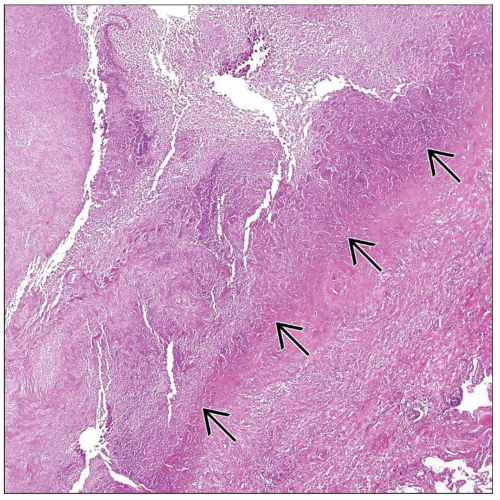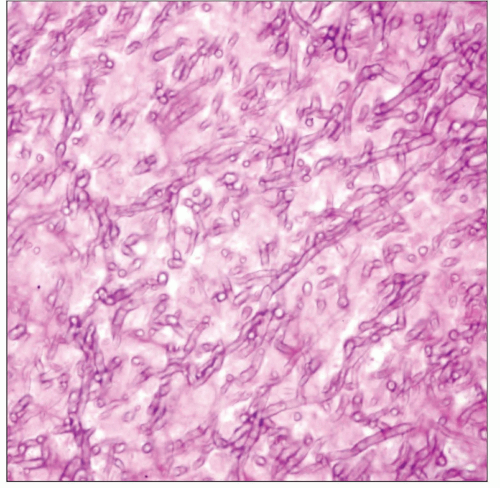Aspergillosis
Key Facts
Terminology
Infection caused by fungus of the species Aspergillus
Clinical Issues
Fungus balls may be asymptomatic and discovered incidentally or can present with massive, life-threatening hemoptysis
Immunosuppressed patients with acute invasive aspergillosis present with cough, fever, and pleuritic pain; infection simulates bacterial bronchopneumonia
Microscopic Pathology
Acute invasive aspergillosis shows foci of necrotic and hemorrhagic parenchyma associated with occlusion of vessel lumens by fungal hyphae
Wedge-shaped infarcts can also occur when large arteries are occluded by fungus
Chronic necrotizing aspergillosis shows large areas of parenchymal consolidation by necrotizing granulomas containing fungal hyphae
Bronchocentric granulomatosis pattern characterized by necrotizing granulomas surrounding bronchiolar walls
Conidial or fruiting heads occur in lesions exposed to air and consist of a vesicle with sterigmata surrounded by chains of conidia
Organisms consist of septate hyphae 3-6 µm in width that branch at acute angles (45°)
Ancillary Tests
Organisms can be seen on H&E stains but are best highlighted with PAS and GMS stains
TERMINOLOGY
Definitions
Infection caused by fungus of the species Aspergillus
ETIOLOGY/PATHOGENESIS
Infectious Agents
Most common species that cause infection are A. fumigatus, A. flavus, and A. niger
CLINICAL ISSUES
Presentation
Several clinical forms of aspergillosis
Colonizing (saprophytic) form in which preexisting cavities are secondarily colonized by the organisms, which form a fungus ball
Allergic bronchopulmonary aspergillosis seen in patients with asthma or cystic fibrosis
Acute invasive aspergillosis tends to occur preferentially in immunocompromised patients
Chronic necrotizing aspergillosis seen in patients with chronic underlying lung disease such as COPD or collagen vascular disorders
Fungus balls may be asymptomatic and discovered incidentally or can present with massive, life-threatening hemoptysis
Immunosuppressed patients with acute invasive aspergillosis present with cough, fever, and pleuritic pain; simulates bacterial bronchopneumonia
Laboratory Tests
Serum precipitins against Aspergillus can be found in > 95% of patients with fungus balls
Sputum cultures can help identify the organisms in patients with fungus balls but may not be helpful in invasive aspergillosis
Treatment
Drugs
Amphotericin B is the drug of choice for acute invasive aspergillosis and chronic necrotizing aspergillosis
IMAGE FINDINGS
Radiographic Findings
Aspergilloma (fungus ball) shows a soft tissue nodule within a preexistent pulmonary cavity or bronchiectatic airway
Fungus ball is usually outlined by a crescent of air along its nondependent surface (“air crescent” sign)
Invasive aspergillosis shows multifocal opacities with ill-defined borders that may progress to large foci of consolidation
CT Findings
Invasive aspergillosis shows focal or multifocal nodular opacities surrounded by ground-glass attenuation (“halo” sign)
MACROSCOPIC FEATURES
Stay updated, free articles. Join our Telegram channel

Full access? Get Clinical Tree





